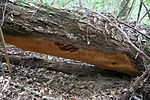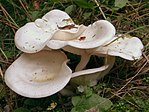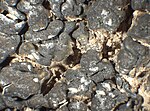There is a page named "Cyanophilous" on Misplaced Pages
View (previous 20 | next 20) (20 | 50 | 100 | 250 | 500)- Cyanophilous article on "cyanophilous", but its sister project Wiktionary does: Read the Wiktionary entry "cyanophilous" You can also: Search for Cyanophilous in Misplaced Pages... 333 bytes (0 words) - 02:55, 11 May 2022
- Perenniporia puerensis millimetre. P. puerensis has a dimitic hyphal system with non-dextrinoid and cyanophilous skeletal hyphae that are encrusted with pale-yellow crystals. The spores... 1 KB (131 words) - 08:02, 18 May 2024
 Ramaria stricta with low cyanophilous warts, and measure 7–10 by 3.5–5.5 μm. The basidia have basal clamps are mostly four-spored, and sometimes have cyanophilous granular... 9 KB (862 words) - 03:55, 21 February 2024
Ramaria stricta with low cyanophilous warts, and measure 7–10 by 3.5–5.5 μm. The basidia have basal clamps are mostly four-spored, and sometimes have cyanophilous granular... 9 KB (862 words) - 03:55, 21 February 2024 Phellinus ellipsoideus The spores have thick cell walls, and are hyaline. They are strongly cyanophilous, meaning that the cell walls will readily absorb methyl blue stain. In... 24 KB (2,991 words) - 17:57, 19 January 2024
Phellinus ellipsoideus The spores have thick cell walls, and are hyaline. They are strongly cyanophilous, meaning that the cell walls will readily absorb methyl blue stain. In... 24 KB (2,991 words) - 17:57, 19 January 2024 Ramaria Spore size may vary considerably, and ornamentation, when present, is cyanophilous. Hjomsköld was the first to introduce the name Ramaria in 1790. Persoon... 14 KB (936 words) - 22:49, 21 November 2024
Ramaria Spore size may vary considerably, and ornamentation, when present, is cyanophilous. Hjomsköld was the first to introduce the name Ramaria in 1790. Persoon... 14 KB (936 words) - 22:49, 21 November 2024 Collybia phyllophila is smooth and they do not glow under UV light. They are inamyloid and cyanophilous. In exsiccates they are usually connected in tetrahedrons. The basidia... 11 KB (1,134 words) - 22:47, 2 December 2024
Collybia phyllophila is smooth and they do not glow under UV light. They are inamyloid and cyanophilous. In exsiccates they are usually connected in tetrahedrons. The basidia... 11 KB (1,134 words) - 22:47, 2 December 2024- Butyrea (with clamps) and skeletal hyphae. The skeletal hyphae are moderately cyanophilous (with cell walls that absorb cotton blue stain), narrow and sinuous,... 3 KB (245 words) - 20:47, 23 April 2024
- Inonotus chrysomarginatus hyphae and hooked hymenial setae, and subglobose, yellowish, thick-walled cyanophilous basidiospores. Cui, Bao-Kai; Du, Ping; Dai, Yu-Cheng (2010). "Three new... 1 KB (118 words) - 01:50, 23 January 2024
 Hirticlavula measure 4.5 to 6.5 by 3–4.2 μm. They are hyaline, and either cyanophilous or containing cyanophilous particles. They contain no prominent crystals, and are... 7 KB (780 words) - 02:44, 3 October 2023
Hirticlavula measure 4.5 to 6.5 by 3–4.2 μm. They are hyaline, and either cyanophilous or containing cyanophilous particles. They contain no prominent crystals, and are... 7 KB (780 words) - 02:44, 3 October 2023- Boidinella ellipsoid basidiospores that have smooth, hyaline (translucent) and cyanophilous walls. The genus name honors French mycologist Jacques Boidin. Nakasone... 2 KB (93 words) - 19:33, 3 January 2024
 Leucocoprinus cepistipes They have a thick wall with germ pore. Dextrinoid, congophilous and cyanophilous. Has a pink inner wall when mounted in Cresyl blue. Basidia: 16–37 x... 25 KB (2,778 words) - 13:25, 28 August 2024
Leucocoprinus cepistipes They have a thick wall with germ pore. Dextrinoid, congophilous and cyanophilous. Has a pink inner wall when mounted in Cresyl blue. Basidia: 16–37 x... 25 KB (2,778 words) - 13:25, 28 August 2024- Leucoagaricus flavus slightly thick wall and no germ pore. Hyaline. Dextrinoid, congophilous, cyanophilous and metachromatic. Basidia: 13-16 x 6–7.5 μm. Clavate. Smell: It has... 5 KB (455 words) - 04:50, 29 January 2024
 Hygrophoropsis aurantiaca 5 micrometres (μm), with walls that tend to thicken in age. The spores are cyanophilous, meaning they will readily stain dark blue in methyl blue solution. Staining... 35 KB (3,333 words) - 23:45, 10 November 2024
Hygrophoropsis aurantiaca 5 micrometres (μm), with walls that tend to thicken in age. The spores are cyanophilous, meaning they will readily stain dark blue in methyl blue solution. Staining... 35 KB (3,333 words) - 23:45, 10 November 2024- Mollicarpus cognatus. Mollicarpus cognatus has short, broadly ellipsoid spores, and cyanophilous binding hyphae that are usually dextrinoid. These features are not present... 3 KB (168 words) - 16:48, 16 January 2024
- Globuliciopsis smooth, hyaline, and feature a slight wall thickening. They are somewhat cyanophilous, but do not react with Melzer's reagent. Hjortstam, Kurt; Ryvarden, Leif... 3 KB (245 words) - 04:24, 12 May 2024
 Leucocoprinus cretaceus amygdaliform with a thick wall and germ pore. Dextrinoid, congophilous and cyanophilous. Has a pink interior in cresyl blue. Basidia: 18–28 x 8.5–12 μm, 4 spored... 23 KB (2,459 words) - 07:51, 30 October 2024
Leucocoprinus cretaceus amygdaliform with a thick wall and germ pore. Dextrinoid, congophilous and cyanophilous. Has a pink interior in cresyl blue. Basidia: 18–28 x 8.5–12 μm, 4 spored... 23 KB (2,459 words) - 07:51, 30 October 2024- Leucoagaricus laosensis amygdaliform, with a thick wall. Hyaline, dextrinoid, congophilous, cyanophilous, and metachromatic. Basidia: 17–20 × 7–8 μm, clavate, and 4-spored. The... 3 KB (340 words) - 03:52, 17 January 2025
 Sistotrema ellipsoid, oblong or allantoid in shape. They are thin-walled and non-cyanophilous, non-amyloid and non-dextrinoid. Cystidia are mostly absent but some... 13 KB (1,148 words) - 05:44, 15 August 2024
Sistotrema ellipsoid, oblong or allantoid in shape. They are thin-walled and non-cyanophilous, non-amyloid and non-dextrinoid. Cystidia are mostly absent but some... 13 KB (1,148 words) - 05:44, 15 August 2024 Clitocybe amarescens The spores measure 6.4 -9.4 x 3.1-4.8 μm. they are congophilus and cyanophilous. They have an obtuse base, and range from elliptical to oblong in shape... 6 KB (554 words) - 14:22, 28 September 2024
Clitocybe amarescens The spores measure 6.4 -9.4 x 3.1-4.8 μm. they are congophilus and cyanophilous. They have an obtuse base, and range from elliptical to oblong in shape... 6 KB (554 words) - 14:22, 28 September 2024 Gloeoheppia 1639/0007-2745(2007)1102.0.CO;2. Marton, K.; Galun, M. (1981). "The cyanophilous lichen population of the 'Arava Valley and the Judean Desert (Israel)"... 10 KB (862 words) - 02:43, 16 September 2024
Gloeoheppia 1639/0007-2745(2007)1102.0.CO;2. Marton, K.; Galun, M. (1981). "The cyanophilous lichen population of the 'Arava Valley and the Judean Desert (Israel)"... 10 KB (862 words) - 02:43, 16 September 2024
- Word definitions from Wiktionarycyanophilous cyanophilous (comparative more cyanophilous, superlative most cyanophilous) (mycology) Having cell walls that readily absorb cotton blue stain. acyanophilousSee all results